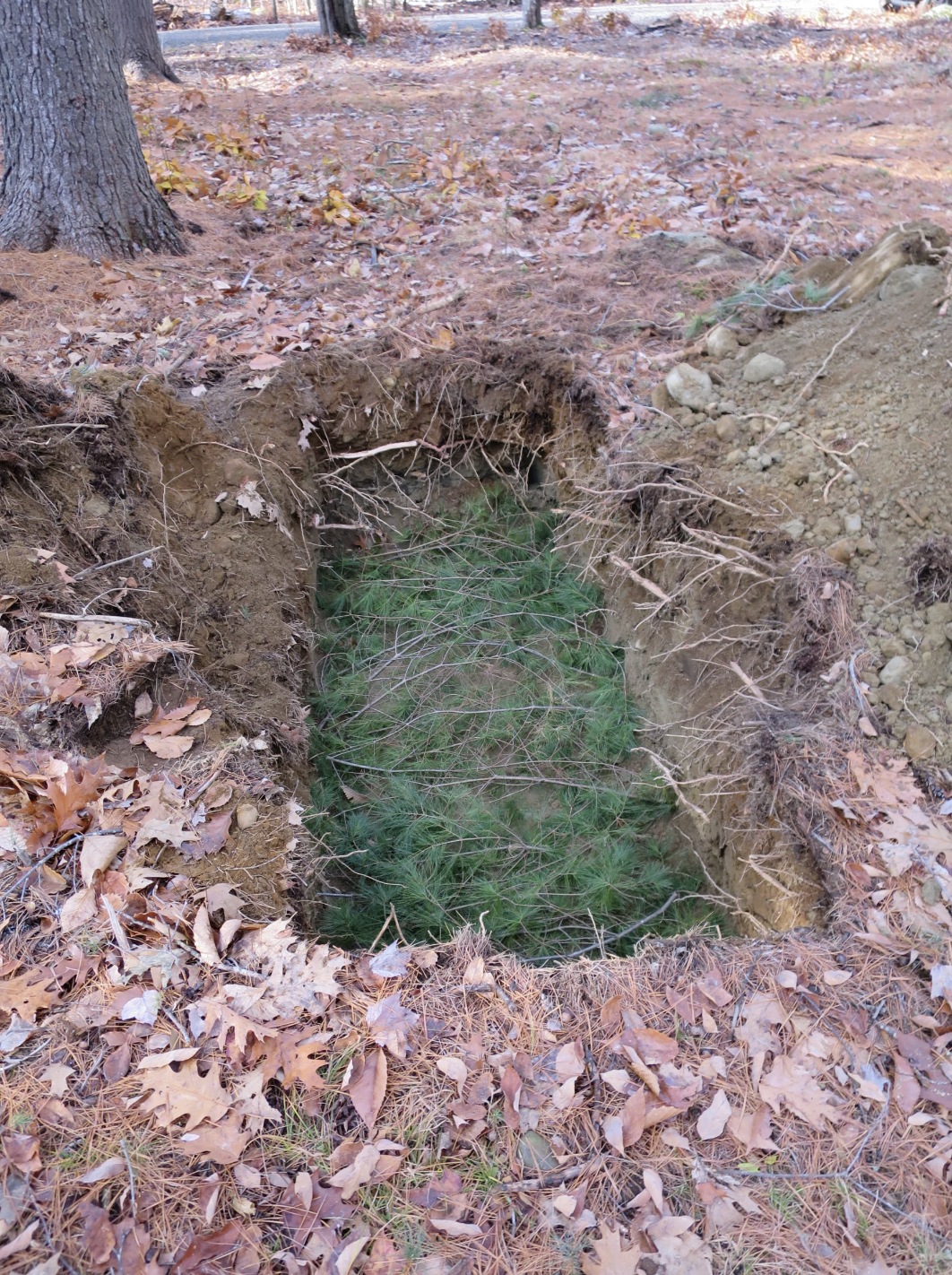By Esta Pratt-Kielley.
It’s a sunny February day as Cathie Murray walks up a trail in Fayette, Maine, snow crunching beneath her boots. She comes upon a grove of tall cathedral pines and oak trees. It’s silent except for the patters of squirrels and the wind rustling the tops of the trees.
This is the spot where Murray says she’ll eventually be buried.
“My whole life I assumed that when I died, I would become part of the Earth to feed back into the cycle. It started when I was a kid, and we buried our pets in the yard … it just seemed really natural to me,” she says. “Of course, when I grew up, I realized, ‘Oh, that isn’t what’s going on.’”
Murray purchased a burial site here, at the Baldwin Hill Conservation Cemetery, which the Kennebec Land Trust recently opened to offer “green burials.” They eliminate the carbon-producing and energy intensive processes that are typical of conventional burials and cremation, such as the use of embalming chemicals, concrete vaults and burning.
“I did want to do something … having the least climate change impact, and also being readily available to the trees, and to the environment,” Murray says.
‘A more environmental way to leave the planet’
Baldwin Hill is the first conservation cemetery in Maine, and the property includes 90 acres of conserved land, with 10 reserved for burials. Until recently, there were two other dedicated green burial cemeteries in Maine. And there are a few conventional cemeteries that have added or are looking to add sections dedicated to green burial.

Green burials aren’t exactly new – most burials prior to the mid-1800s would have been considered “green” or natural, with a body buried in a simple box or shroud. However, after the Civil War, embalming bodies for public viewing became the American standard.
Murray is among the increasing number of people now opting for a green burial. Sixty percent of Americans say they’re interested in exploring green funeral options because of the environmental benefits and cost savings, according to the National Funeral Directors Alliance.
“The majority of people are looking for a more environmental way to leave the planet, they’re looking for a better exit,” says Lee Webster, a green burial advocate and the former president of the Green Burial Council, an advocacy and educational nonprofit that certifies cemeteries nationwide.
Webster says the environmental benefits of a green burial are strong. While traditional or conventional burial produces an estimated 250 pounds of carbon, green burial sequesters 25 pounds of carbon, according to Green Burial Council. The body also releases nutrients back into the soil, including carbon, nitrogen, phosphorus, and potassium. Then there’s the added sequestration of greenhouse gases through land conservation for cemeteries like Baldwin Hill.
“When we learn that our bodies can contribute to carbon sequestration – as opposed to expenditure – it flips the switch for a lot of people,” she says.
Every year, burials in the United States use about 4.3 million gallons of embalming fluid; 20 million board feet of hardwoods, including rainforest woods; 1.6 million tons of concrete; and 64,500 tons of steel. Caskets and burial vaults leech iron, copper, lead, zinc and cobalt into the soil, according to research by Mary Woodson for the Green Burial Council.

And while about 80% of Mainers are now opting for cremation, according to the National Cremation Association of North America, it comes with its own environmental cost. Cremation requires an average of 28 gallons of fuel — about enough to fill an SUV’s gas tank — and also releases carbon monoxide and sulfur dioxide into the atmosphere, as well as mercury from dental fillings. Researchers at Columbia University have found that cremating a single body is equivalent to the average home’s monthly household energy consumption.
By contrast, green burial requires only a biodegradable casket or organic burial shroud. The grave is dug about 30 inches deep, ideal for aerobic decomposition —essentially, composting.
The Kennebec Land Trust Stewardship Director Jean-Luc Theriault says the grave is lined with pine boughs.

“And we bring out pine boughs, to lay in the bottom of the grave and alongside, and then the family is welcome to bring on, you know, biodegradable flowers or anything else that they’d like to bring to the service,” he says. “But then everything else is, you know, very similar to a normal service.”
Green burial is also often a cheaper option. The median funeral cost of a funeral and burial with a viewing in New England is $7,881, and $7,069 for a cremation, according to the National Funeral Director’s Alliance. At Baldwin Hill, plots cost $1,200 to purchase, or $1,000 for Kennebec Land Trust members and residents of Fayette. There are some additional costs for the funeral home and purchasing either a pine box or organic burial shroud, but the overall expense is typically much less.
But green burials come with a unique set of challenges. Without the embalming preservation, bodies need to be interred more quickly. And while there are 350 certified green burial cemeteries nationwide — and more that aren’t certified — many people don’t live close enough to one. And many local municipal cemeteries still require vaults in their bylaws.
Conservation burial to further save land
Conservation cemeteries, which have green burials located on preserved lands, require land acquisition and often getting land trusts on board. There are 20 certified conservation cemeteries nationwide, including Baldwin Hill.
The Kennebec Land Trust Executive Director Theresa Kerchner says she hopes they can serve as a model for other land trusts and municipalities to follow. She says partnering with local funeral homes was key to taking on the cemetery, and also a strategy to increase regional knowledge of green burial practices.
“One of the things that we really focused on is how can we model this process in our part of Maine, so that it would become more common, and it wouldn’t seem like it was such a big hurdle for municipalities to think about in their cemeteries,” she says.
Webster says conservation burial is critical in further saving land, in part by creating emotional ties between people and the land.
“That’s just one little piece of the puzzle here, about climate resiliency, is using this land in multipurpose ways that do the job we’re looking to do, which is protect the land to protect life, our own and everybody else’s,” she says.

For Murray, furthering land conservation is a meaningful part of her burial planning.
“I really like the idea that by investing in this space for my burial, I’m also supporting a big open space in the area,” she says.
As a cancer survivor, Murray says planning her burial has brought her a sense of peace, which she hopes her family will also feel when she’s eventually laid to rest here.
“I think about my kids carrying me here” she says. “It feels like a good ritual, you know, to really acknowledge that this earthly body has done its part, and it’s over. And I like to think about them bringing me here and feeling at peace with what’s happened, and that it’s a place that they can return to and feel that same peace.”
Read the full article by Esta Pratt-Kielley here.



